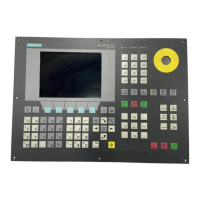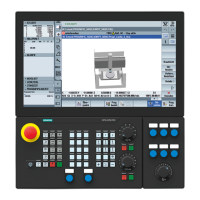1.7.2 Substitution characters
The system offers
the option of defining control properties (attribute values) for the runtime. In
order to use this function, the desired property must be set in a local variable and the variable
name must be transferred to the tag as an attribute value preceded by the character $.
If the tag expects a string as attribute value or value, the $$$ characters must be placed in
front of the variable name.
Example:
<let name="my_ypos">100</let>
<let name="field_name" type="string"></let>
<control name = "edit1" xpos = "322" ypos = "$my_ypos" refvar="nck/
Channel/Parameter/R[1]" />
<op>my_ypos = my_ypos +20 </op>
<control name = "edit2" xpos = "322" ypos = "$my_ypos" refvar="nck/
Channel/Parameter/R[2]" />
<print name =" field_name" text="edit%d">3</print>
<op>my_ypos = my_ypos +20 </op>
<control name = "$field_name" xpos = "322" ypos = "$my_ypos"
refvar="nck/Channel/Parameter/R3]" />
<caption>$$$field_name</caption>
1.8 Addressing components
Address identifiers for the desired data must be created to address NC variables, PLC blocks
or drive data. An address consists of the subpaths component name and variable address. A
slash should be used as a separating character.
1.8.1 PLC addressing
Addressing the PLC starts with the path section plc.
Table 1-3 The following addresses are permissible:
DBx.DB(f) Data block
I(f)x Input
Q(f)x Output
M(f)x Bit memory
V(f)x Variable
Generating user dialogs
1.8 Addressing components
Easy XML
74 Programming Manual, 10/2015, 6FC5397-3DP40-5BA3

